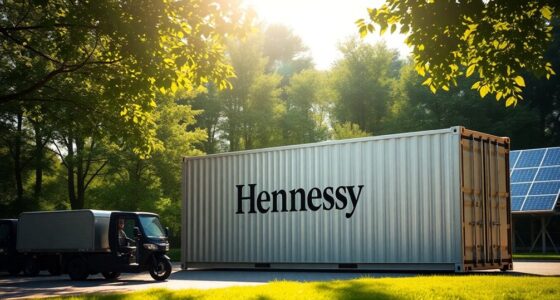Fast fashion harms the environment by polluting water with toxic dyes, producing massive textile waste, and emitting high levels of greenhouse gases. It relies on overproduction, cheap labor, and synthetic fibers that take decades to decompose, contributing to landfills and microplastic pollution. This cycle wastes resources like water and land and accelerates climate change. To understand the far-reaching impacts—and how your choices can make a difference—keep exploring the true cost behind your clothing.
Key Takeaways
- Fast fashion’s mass production causes significant environmental pollution, resource depletion, and contributes heavily to climate change.
- The industry relies on toxic dyes and chemicals that contaminate water sources and harm ecosystems.
- Short-lived garments generate vast textile waste, often ending in landfills or polluting oceans with microplastics.
- Sustainable fashion reduces environmental impact, conserves resources, and promotes ethical labor practices.
- Investing in eco-friendly clothing supports long-term ecological health and fosters responsible consumer behavior.
The Environmental Toll of Fast Fashion

Have you ever wondered what happens to the environment when you buy a cheap, trendy piece of clothing? Fast fashion relies on mass production, which leads to enormous waste and pollution. To create inexpensive garments quickly, brands often use toxic dyes and chemicals that pollute rivers and soil. The constant churn of new collections encourages overproduction, resulting in mountains of textile waste that often end up in landfills, where synthetic fibers can take decades to decompose. Additionally, the energy-intensive manufacturing process consumes vast amounts of fossil fuels, contributing to greenhouse gas emissions. This cycle damages ecosystems, depletes natural resources, and harms wildlife. Your quick purchase fuels this environmental strain, making fast fashion a significant contributor to environmental degradation worldwide. Fokos highlights the importance of sustainable practices in the fashion industry to reduce such impacts. Recognizing the environmental impact of fast fashion can inspire consumers to make more conscious choices, especially as the environmental toll continues to grow. Moreover, adopting ethical manufacturing standards can play a crucial role in mitigating these adverse effects, and utilizing sustainable materials can further lessen the ecological footprint of clothing production.
The Human Cost Behind Cheap Clothing

While fast fashion’s environmental damage is widely recognized, the human cost behind these cheap clothes often goes unnoticed. When you buy that inexpensive shirt or pair of jeans, you’re supporting a system that often exploits vulnerable workers. Many garment workers face unsafe conditions, long hours, and low wages that barely cover their basic needs. In some factories, workers endure forced labor, harassment, or exposure to dangerous chemicals. Children are sometimes employed to cut costs further. These workers often lack basic rights or protections, and their health suffers from hazardous environments. Your desire for cheap fashion fuels this cycle, perpetuating exploitation. Additionally, the lack of ethical sourcing in many supply chains means these issues persist unchecked. Understanding the supply chain complexities involved can help consumers make more informed choices. Recognizing the importance of worker safety standards can drive demand for more responsible production practices. Supporting companies that prioritize fair wages and safe work environments is essential for fostering change. Moreover, increased awareness of labor rights violations can empower consumers to advocate for ethical fashion practices. Choosing sustainable fashion means respecting the humanity behind each garment, ensuring fair wages, safe work environments, and dignity for those who make your clothes.
The Lifecycle of Fast Fashion Garments
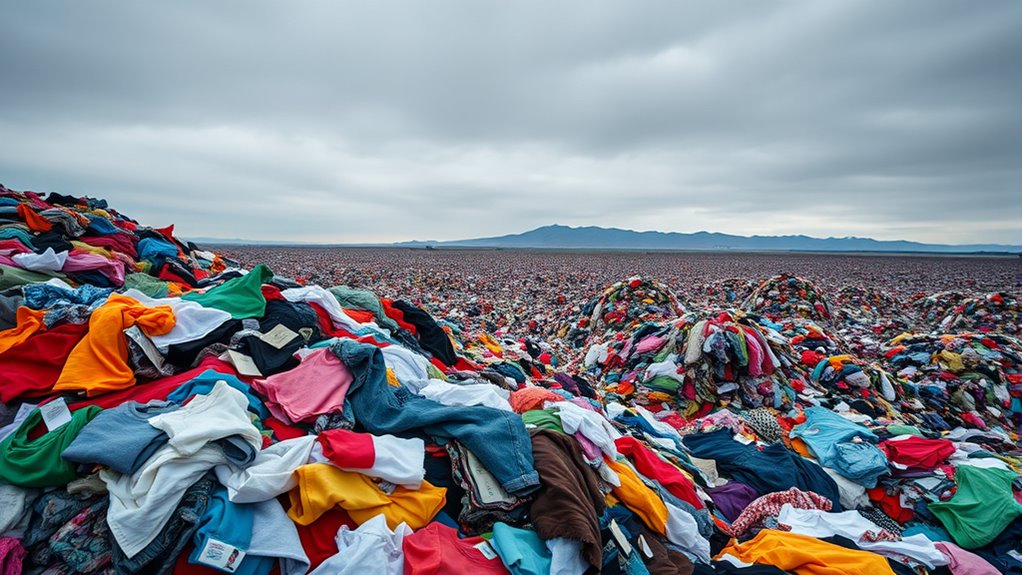
The lifecycle of fast fashion garments is a rapid and resource-intensive process designed to maximize profit and minimize production costs. From design to disposal, each stage is optimized for speed and affordability, often at the expense of quality and sustainability.
Here’s what happens:
- Design and Production: Trends are quickly translated into cheap materials, resulting in mass production that prioritizes quantity over durability.
- Distribution and Consumption: Clothes reach stores fast, encouraging frequent purchases and quick disposal by consumers.
- End of Life: Most garments are discarded after only a few wears, ending up in landfills, where they can take years to decompose.
This cycle fuels environmental waste and promotes a throwaway culture, making fast fashion unsustainable in the long run.
The Impact on Water and Land Resources

Fast fashion consumes vast amounts of water during production, often wasting resources and harming ecosystems. Growing cotton for textiles can lead to land degradation and soil erosion, damaging local habitats. Additionally, dyeing processes release pollution into water sources, threatening both wildlife and communities. Moreover, the use of environmentally friendly practices in sustainable methods can help reduce environmental impact over time. Implementing regulatory standards can further incentivize companies to adopt eco-friendly techniques and minimize their ecological footprint. Incorporating water conservation techniques in manufacturing can also significantly decrease water usage and lessen environmental strain.
Water Consumption in Production
Have you ever considered how much water goes into making your clothes? Fast fashion production consumes staggering amounts of water, affecting both resources and ecosystems. Here’s how:
- Cotton cultivation requires about 2,700 liters of water for just one T-shirt, depleting local water sources.
- Dyeing processes use toxic chemicals and large quantities of water, polluting nearby water bodies.
- Fabric finishing often involves water-intensive treatments, adding to the overall consumption.
- The reliance on water-intensive processes in production can lead to water scarcity in vulnerable regions.
Land Degradation From Cotton
Although cotton farming provides a key raw material for the fashion industry, it often leads to severe land degradation. Large-scale cotton cultivation depletes soil nutrients, making the land less productive over time. To meet demand, farmers frequently clear forests or grasslands, destroying natural habitats and reducing biodiversity. Intensive water use for irrigation causes salinization and erosion, further damaging the land. This process leaves soil vulnerable to desertification, where fertile land turns into unproductive desert. Unsustainable farming practices can also lead to compaction and loss of soil structure, reducing its ability to support plant life. Additionally, recycled materials are increasingly used as sustainable alternatives to traditional cotton, helping to mitigate some environmental impacts. Furthermore, implementing environmentally conscious farming practices can significantly reduce land degradation. Soil health management is crucial for maintaining land productivity and preventing long-term damage. Promoting conservation agriculture techniques can enhance soil resilience and support sustainable land use. Incorporating innovative regenerative farming practices can further improve soil quality and reduce environmental harm. Over time, these impacts diminish land health, threaten local ecosystems, and undermine the long-term sustainability of cotton production.
Pollution From Dyeing Processes
Did you know that the dyeing processes in the fashion industry can severely harm water and land resources? When factories use toxic chemicals to color fabrics, these pollutants often end up in nearby rivers and soil. This contamination affects ecosystems and communities that depend on clean water. Additionally, adopting more sustainable anime movies and eco-friendly practices can help reduce environmental impact. Here are three ways dyeing impacts resources:
- Water Pollution: Toxic dyes and chemicals seep into water supplies, harming aquatic life and making water unsafe for drinking.
- Soil Contamination: Waste from dyeing processes can settle in the land, poisoning crops and reducing land fertility.
- Resource Waste: Large amounts of water are used for dyeing, often wasted or contaminated, leading to shortages and environmental stress.
Reducing dyeing pollution is vital for protecting our water and land for future generations.
The Carbon Footprint of the Industry

The fast fashion industry considerably contributes to global carbon emissions, making it one of the largest industrial polluters today. Every step, from raw material extraction to production and transportation, releases significant greenhouse gases. When you buy fast fashion, you’re indirectly supporting a system that relies heavily on fossil fuels, especially in manufacturing countries. The quick turnaround of trendy clothing means factories operate at high capacity, often with minimal energy efficiency. Additionally, the global supply chains involve long-distance shipping, which adds to carbon emissions. This relentless pace accelerates climate change, impacting ecosystems and communities worldwide. If you want to reduce your carbon footprint, consider choosing sustainable brands or buying fewer, higher-quality pieces that last longer. Your choices can help lessen the industry’s environmental impact. Understanding industry practices can help consumers make more informed purchasing decisions.
How Fast Fashion Fuels Waste and Pollution
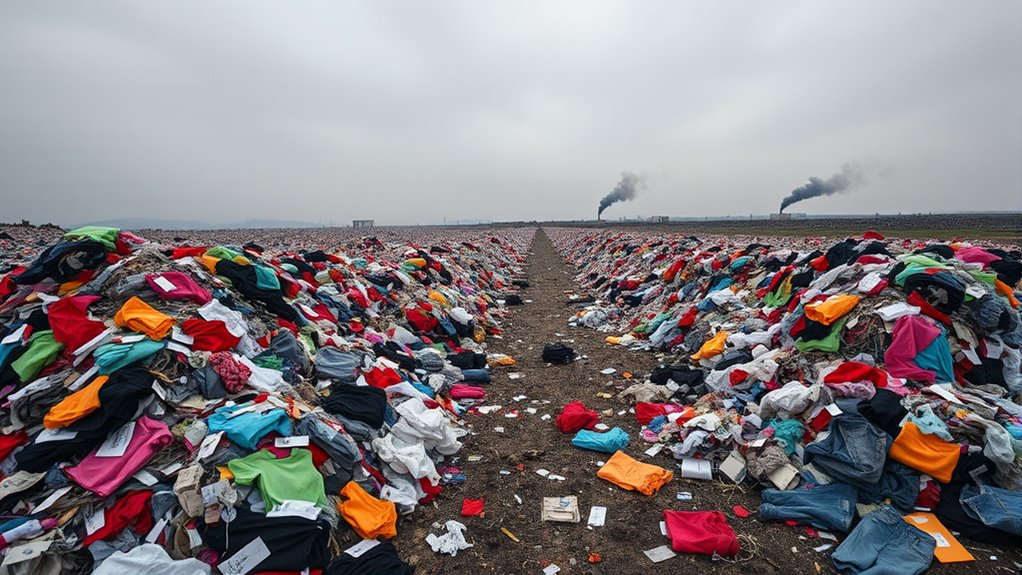
Fast fashion markedly accelerates waste and pollution because it encourages consumers to buy and discard clothing at an unprecedented rate. This cycle results in mountains of textile waste, much of which ends up in landfills, taking years to decompose. Additionally, fast fashion’s reliance on cheap, synthetic fibers releases microplastics into oceans every time you wash these garments. The industry’s quick turnover also means factories often cut corners, leading to environmental contamination and pollution. Here’s how it impacts you:
- Mass production produces excess fabric waste that’s often burned or dumped.
- Synthetic fibers shed microplastics, polluting waterways and harming marine life.
- Short-lived garments lead to continuous waste, fueling landfill overflow.
Moreover, the fast fashion industry’s focus on rapid, high-volume output often results in environmental degradation, contributing to broader ecological issues.
Benefits of Embracing Sustainable Fashion
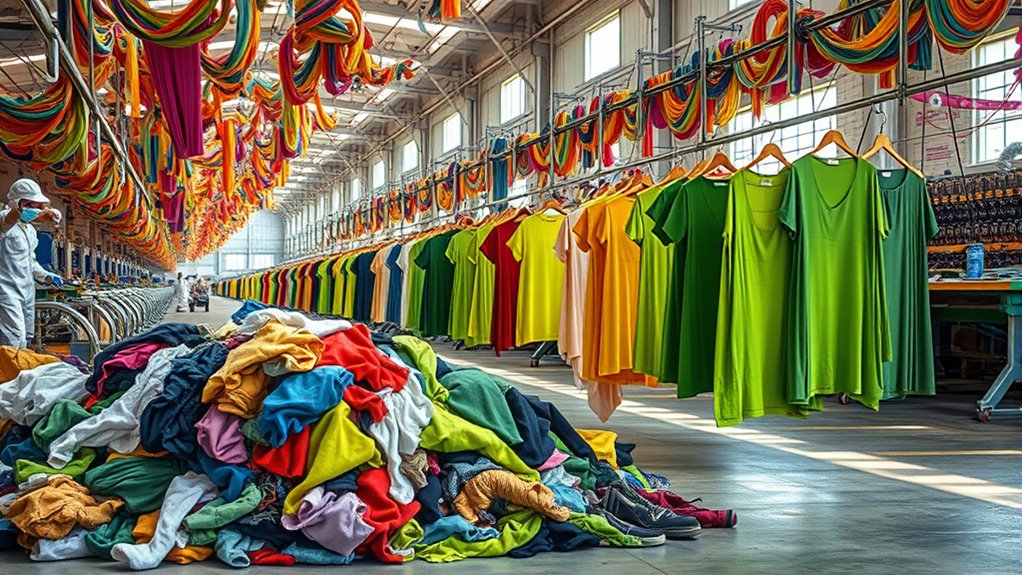
Choosing sustainable fashion helps safeguard the environment by reducing pollution and conserving resources. It also supports ethical production practices that ensure fair treatment for workers. Over time, these choices can lead to significant economic savings for you and the planet. Additionally, embracing sustainable fashion fosters creative practice, encouraging innovative approaches to design and production that minimize waste and promote resourcefulness. Incorporating sustainable materials in your wardrobe can further enhance environmental benefits and promote durability. Recognizing the importance of glycolic acid in skincare routines highlights the value of choosing ingredients and materials that are both effective and environmentally friendly. Understanding the best beaches can inspire eco-conscious travel choices that support conservation efforts.
Environmental Preservation Benefits
Embracing sustainable fashion considerably benefits environmental preservation by reducing harmful waste and conserving resources. When you choose eco-friendly clothing, you help cut down on textile waste that often ends up in landfills, polluting the environment. Additionally, sustainable practices focus on using fewer resources, such as water and energy, during production. This means less strain on our planet’s finite supplies. Here are some specific benefits:
- Decreased landfill waste from fewer discarded garments.
- Lower water and energy consumption in manufacturing processes.
- Reduced pollution from toxic dyes and chemicals used in production.
Ethical Production Practices
When you support sustainable fashion, you promote ethical production practices that prioritize fair treatment of workers and responsible manufacturing. This means garments are made in safe, humane conditions, and workers receive fair wages. You help break the cycle of exploitation often seen in fast fashion factories. Your choices encourage brands to be transparent and accountable, fostering a culture of integrity. The impact extends beyond workers; it promotes healthier communities and reduces harm caused by unsafe working environments.
| Fair Wages | Safe Conditions | Transparent Practices |
|---|---|---|
| Dignity for workers | Reduced accidents | Honest supply chains |
| Empowerment | Better health | Trust in brands |
| Stability | Human rights upheld | Ethical commitments |
Long-Term Economic Savings
Opting for sustainable fashion can lead to significant long-term savings by reducing the need for frequent replacements and repairs. When you invest in high-quality, durable pieces, you avoid constantly buying new clothes. Over time, this saves you money and time. Here are some benefits:
- Fewer Purchases: You buy fewer items, which cuts down on overall spending.
- Lower Maintenance Costs: Sustainable fabrics often require less care, saving money on dry cleaning or repairs.
- Better Investment: Quality clothing lasts longer, giving you more value for each dollar spent.
How Consumers Can Make More Ethical Choices
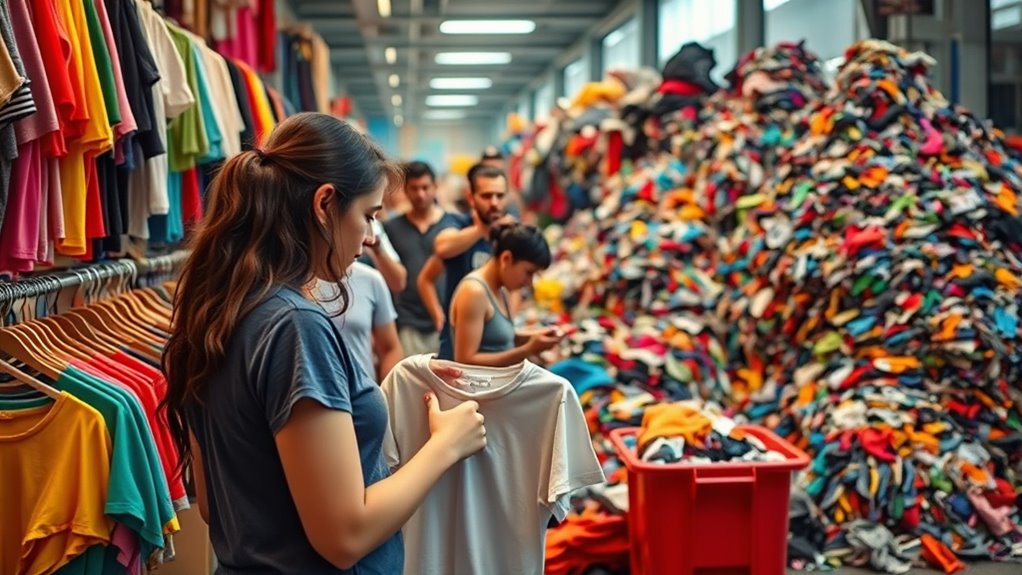
To make more ethical choices as a consumer, you need to become informed about the true cost of fast fashion. Research brands’ sourcing and manufacturing practices before buying. Look for companies committed to fair wages, safe working conditions, and sustainable materials. Consider purchasing from local or secondhand stores to reduce environmental impact and support ethical businesses. Prioritize quality over quantity—invest in durable pieces that last longer. Be skeptical of cheap prices, which often reflect exploitation or environmental harm. Use apps and websites that rate brands’ ethical standards. Finally, reduce your overall consumption by rethinking your wardrobe needs. Small changes, like choosing eco-friendly brands and repairing clothes instead of discarding them, can make a significant difference in promoting sustainable fashion.
Frequently Asked Questions
How Does Fast Fashion Affect Local Economies Worldwide?
Fast fashion impacts local economies worldwide by prioritizing cheap, quickly produced clothing that often undercuts local artisans and small businesses. When you buy fast fashion, you’re contributing to job losses in traditional industries and reducing demand for locally made goods. This shift weakens local economic growth, especially in developing countries where many garments are manufactured. Supporting sustainable fashion helps protect these local economies and promotes fair, ethical trade practices.
What Are the Long-Term Health Effects for Garment Factory Workers?
You might not realize it, but working in garment factories can have serious long-term health effects. Exposure to toxic chemicals, poor ventilation, and repetitive strain can lead to respiratory problems, skin issues, and musculoskeletal disorders. Over time, these health risks accumulate, affecting your quality of life and longevity. It’s important to recognize these dangers so you can advocate for better working conditions and safer practices in the industry.
Can Sustainable Fashion Be Affordable for Most Consumers?
You might think sustainable fashion is expensive, but it can be affordable if you choose wisely. Many brands now offer eco-friendly options at lower prices, especially when you buy less and prioritize quality over quantity. Thrift shopping and swapping clothes also help save money while reducing waste. By making smarter choices, you can enjoy stylish, sustainable pieces without breaking the bank, proving that eco-conscious fashion is within your reach.
How Do Clothing Brands Justify Their Environmental Impact?
Clothing brands justify their environmental impact by highlighting efforts to reduce waste, use sustainable materials, and improve manufacturing processes. They often claim that investing in eco-friendly practices benefits the planet and appeals to environmentally conscious consumers like you. Some brands also argue that their innovations and certifications demonstrate their commitment to sustainability. While these efforts matter, it’s up to you to scrutinize whether their actions match their claims and truly minimize environmental harm.
What Innovations Are Emerging to Reduce Fashion’S Ecological Footprint?
You’re curious about innovations reducing fashion’s ecological footprint. New technologies like biodegradable fabrics and waterless dyeing methods are emerging, helping brands cut waste and pollution. Sustainable materials such as recycled fibers and plant-based textiles are gaining popularity. Also, digital tools like 3D design and virtual fitting reduce sample production and returns. These advances make it easier for you to choose eco-friendly fashion, encouraging brands to prioritize sustainability and lessen their environmental impact.
Conclusion
Choosing sustainable fashion is like planting seeds for a healthier planet and fairer future. Every time you opt for eco-friendly clothes, you help cut down pollution, save water, and support ethical workers. Your choices ripple outward, turning fast fashion’s storm into a gentle breeze of change. So, wear your values proudly—because small steps by you can lead to a giant leap toward a cleaner, kinder world.




